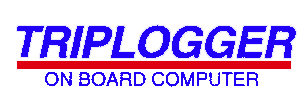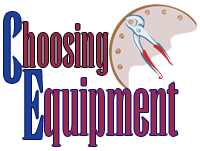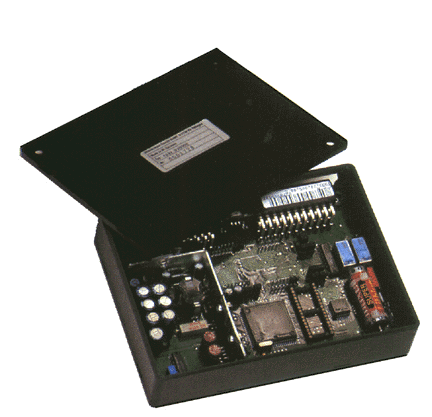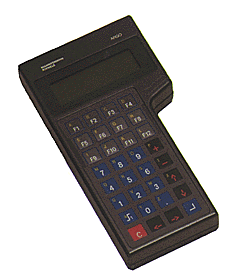Onboard Computers Combine
Science and Sweeping

Data logging equipment provides a wide variety
of benefits from meticulous cost tracking to employee accountability and equipment wear.
Tachographs, sometimes called 'strip chart recorders,' have been used
for years to monitor activity or 'events' in the trucking and related industries.
An 'event' is basically anything that can be tracked via the opening or
closing of a relay, contact, or switch. In the sweeping industry, traditional
tachographs have primarily been used to track sweeper speed, both en route
and during sweeping. They have also been used to gauge the time when the
actual sweeping mechanism was operating (broom turning or sweeping head
down). Typical tachographs have 3 'styli' (pens), each marking different
areas on a circular chart. These show whether the sweeping apparatus was
operating or in a non-sweeping mode. By studying the paper readout made
by the styli, owners can evaluate what took place on the sweeper's route.
Many tachograph users claim the machines pay for themselves simply by reducing
the number and duration of breaks taken by operators.
Analysis of the data can be done at a glance, and no computer hardware
whatsoever is needed. Another advantage for tachograph users is the ability
to verify any particular log from a given day. In conjunction with a routing
sheet, tachographs are a viable method of tracking driver activities and
analyzing the amount of time spent at each client location. A record keeping
system can consist of simply stapling the tachograph chart onto the appropriate
paperwork.
These mechanical tachographs are also relatively inexpensive. Prices
start at about $250 per unit, and go up to the $1000 area for more sophisticated
units. For owners of multiple sweepers, however, a problem has always been
getting the relatively large amount of sweeping data tachographs generate
into a usable format. Although it doesn't take long to read each individual
printout, compiling the information over the long term involves a moderate
amount of data entry. Now, however, computer technology has taken the science
of tracking sweeper usage to a new, much higher level.
Today's electronic versions are veritable onboard computers that have
proven to be extremely durable in a variety of rugged applications. The
typical chip-based data collector fits into a casing barely 6 inches square,
and may be connected via wires to almost any component on the sweeper. This
factor alone extends their overall value substantially over mechanical tachographs.
Imagine being able to closely monitor your sweeper's brooms, sweeping
head, engine(s) speed, dust system water level, odometer, tachometer, brakes
and more. On some data collection models, a wide range of additional information
can also be added by the operator via a keypad. This allows for entry of
information specific to clients and routes, sweeper repairs needed, start/finish
time - whatever factors are important to streamlining your operation. Output
information is transferred to a PC, where the data stream can be exported
to a computer for complete analysis and printout.
Typical queries include average time spent per customer, number and length
of operator breaks taken, average (or top) speed of both travel and sweeping,
and hard braking events. A host of sweeping-specific data can also be gleaned,
such as how long dust suppression water is lasting, auxiliary engine speed,
broom activity, sweeping without water, time it takes to perform tasks like
dumping the hopper and filling the water tank, etc. At management's option,
exceeding a predefined level triggers an automatic alert.
Companies are also using data from onboard computer systems to develop
driver bonus plans, operator safety and efficiency guidelines, automatic
maintenance programs, vendor product comparisons and increases in fuel efficiency.
The data collectors are also an invaluable resource in the event of accidents,
injury or accusations being made about an operator, or the quality of the
job that was getting done.
Monitor and record nearly everything your sweeper does
for accountability and accurate cost analysis.
Since July of 1996, Los Angeles County has required that electronic data
collection units be installed in the sweepers of any contractor it hires.
This requirement is included right in the bid specifications. Bill Bird,
C.E., researched the concept for L.A. County. He chose a system called the
Triplogger 5000 as the county's 'baseline unit.' Contractors must either
use that model, which is manufactured by Sun Instruments USA, or a competing
data collector which qualifies as an approved equal.
"We wanted to develop a level of accountability with our contractors,"
said Bird, "and requiring computerized data collection allows us to
get it. The readouts we mandate are brooms on/off (or sweeping head up/down),
miles per hour while sweeping, and total miles swept. Using this data, our
county oversight officials are able to review and confirm what we feel are
the most important aspects of our out-sourced sweeping operations, right
from their computers.
"For example, we currently require that speed not exceed 6 mph when
sweeping. The Triploggers let us track that, as well as see exactly how
long it's taking to do the various routes. We definitely think it adds cost-effectiveness
to our program. We have had minor software challenges; however, this is
primarily because the data is output in an encrypted form so it can't be
changed by any parties after collection. That's been pretty much straightened
out, however."
Joe Samuelian, owner of Nationwide Environmental Services (a division
of Joe's Sweeping, Inc.) is one of the contractors who sweeps for L. A.
County [see related article, Feedback From
An L.A. County Contractor]. He speaks highly of the onboard computer
concept. "I think the idea of the data logger is fantastic," said
Samuelian. "Good for both the customer and for me. We've used the old
style tachograph, but this new computerized system is much better for a
large fleet. With the data download, we know on a day-by-day basis how many
curb miles we swept, how fast we went, when drivers are taking breaks -
or if they weren't working. I now know exactly what my drivers are doing.
"The information is really quite easy to download and read. We've
added the Triplogger to two of our other sweepers, and we'll be adding more
as we go along. What I don't agree with is L.A. County's decision to require
sweeping at a maximum of 6 mph, since that's several miles per hour under
what the sweeper manufacturer suggests; however, that's another story."

According to Burgess McDaniel, spokesperson for the
manufacturer of the Triplogger, "New parameters are easily programmed
into the system. It has an alphanumeric, driver-entry keypad which the operator
can use to code in a variety of information, such as client numbers, route
number, dumpsite or whatever else management wants to assign to particular
key sequences. It's also used to code in a change of operators. When the
data is downloaded, the keypad sequences are automatically transformed into
the name of the client, driver, etc., for reporting purposes.
"Data removal is via a downloader module about the size of a cigarette
pack. It plugs into both the Triplogger unit and a PC computer. Alternatively,
a cable adapter is available which connects directly from the onboard module
to, for example, a computer located at the sweeper fueling station. Direct
transfer to a laptop or palmtop computer is also available, and is getting
to be more and more popular.
"Once downloaded, data can easily be put into a report format. These
can include information as general as speed overage, or as specific as hard
braking reports. For example, with a sensor on both the brake light switch
and the speedometer, an owner might want to generate a report showing how
many times the brakes were hit at, say, 025 mph, 2540 mph, and
above 40 mph. Combined with an elapsed time sensor, the analysis could further
show any braking done too quickly. The information that can be collected
is really just a factor of management's creativity in what to monitor, what
reports to generate."
Tony Reynolds is the national fleet marketing manager for Argo Instruments,
Inc., another manufacturer of data collection units. Argo modules are specified
for use by sweepers in the city of Los Angeles, as well as for the cities
of Las Vegas and San Diego, among others.
"We provide a turnkey solution that lets management keep track of
virtually any aspect of their sweepers they'd like," said Reynolds.
"In the City of Los Angeles, they monitor all the standard data, as
well as water tank level, spray bar use, hopper filling and dumping, use
of both the main brooms and the gutter brooms, as well as turn signals and
warning lights. With all that, a very wide variety of in-depth analysis
can be made.
Part of the typical payback is a verifiable increase
in productivity and a reduction in customer complaints.
"We help organizations get focused on their economics
the return on their investment. For example, with our units a fleet can
determine their exact labor rate, and how much they're paying in overtime,
both per sweeper and total. Part of the typical payback is a verifiable
increase in productivity and a reduction in customer complaints. And if
they do get a complaint, an owner can verify and prove exactly what went
on at a given time and location.
"We provide sweeper owners with the ability to start thinking in
terms of cost of operation per shift, and ways to measure what factors are
costing them extra money. If a company has a sweeper doing twenty strip
malls per night, they're able to break down how the time was spent at each
one. The software is very helpful. You set it up by filling in the blanks
and defining parameters. It's also easy to add specific 'profiles.'
"Perhaps a company doesn't want its sweepers driving faster than
32 miles an hour through residential neighborhoods. The software can be
set up to indicate a speed violation every time a predetermined speed is
exceeded. That sort of information was theoretically available on the old
style of strip chart recorders, but not without going through reams of paper
to get it. Now, as an example, with literally a push of a button managers
can get a readout showing exactly how many speed violations occurred on
a particular route or with a certain driver over whatever span of time they'd
like.
"We emphasize to our users that they now have the opportunity to
hone in on areas that cost them money, tend to wear out their equipment,
or adversely affect payroll. A profile might show anything over a 10 minute
downtime stop, or be set up to recognize that any time the brushes are going
for more than 30 seconds without the lights flashing, it should be flagged
as a safety violation. These devices bring a whole new ability to verify
and control costs to the sweeping industry, whether it's for the in-house
fleet of a large municipality or for a small contractor trying to get a
handle on his real costs."
The Argo Instruments' data collector, model number FMS1332, is in an
extremely durable, shock-resistant box about 6 inches square by 2 inches
thick. Driver input keypads are available, as well as a dashboard receptor
which accepts what Reynolds called an 'operator key fob.' About the size
of a dime, it contains a chip which identifies each sweeper operator. When
touched onto the unit's receptor, that particular operator is logged onto
that specific vehicle. An interlock may also be added, such that if the
driver doesn't log on, the vehicle doesn't start and/or sounds an alarm.
Many companies use this profile to derive payroll data.
|
|
|
|
| Argo Unit |
Argo Unit Downloader |
Abbot Unit |
Zepco Unit |
Don Heinze is the president of Speede Speedometer, Inc., a distributor
for both Abbott tachographs and the Zepco and Veeder Root lines of onboard
computer data collection devices. His company is located in Bell Gardens,
California, near Los Angeles. "A lot of cities in this area have gone
to privatized contract sweeping," said Heinze. "They use one or
more sweeping contractors, rather than continuing to operate their own sweepers
in-house. Many of these cities require a tachograph, and some now require
an onboard computer. Some even require both. The most popular information
specified is total sweeping time, curb miles swept, and the speed the sweeping
was conducted. Usually there's a requirement for a maximum speed of either
8 or 10 mph. The prevailing belief is that sweeping too fast is much less
effective and causes significantly more wear to peripherals like brooms.
City managers are much more comfortable with contracting
when they can get a readout on what has been done.
"City managers are much more comfortable with contracting when they
can get a readout on what has been done. The requirements usually include
miles swept, deadhead miles, total time spent on a route, speed while sweeping
and, optionally, time spent either filling up or emptying the water supply
or hopper. The information can make a real difference in overall operational
expense. We installed tachographs several years ago in the sweepers of the
city of Las Vegas. They calculated about a 60% improvement in productivity
in the first year.
"Last year we were contacted by the head of sweeping in a nearby
city. It seems that when its sweeper fleet had been purchased several years
previously, their order had been combined with the sweeper order of the
county in which the city was located. The county had spec'ed in tachographs
as part of the bid, so when the city's sweepers arrived they had the tachographs
on them, too. At the time, unfortunately, no one in the city's public works
department knew what 'those black boxes' even were! As a result, the tachographs
never got used until last year when a new department head came on board.
He recognized what the units were and tried to start using them.
"The tachographs wouldn't work because they hadn't been maintained.
However, since our decal was on them he called us up. To make a long story
short, the city soon attained such high productivity that they no longer
need as many sweepers for their existing routes. They ended up moth-balling
2 sweepers in their 11 sweeper fleet. That's an example of the kind of impact
that even mechanical tachograph devices can have.
"Anytime there is an ongoing situation involving a vehicle, a driver,
and a lack of supervision, there's no question that these kinds of tracking
solutions can save time and money and provide accountability," said
Heinze. "We provide onboard tracking devices to a wide range of industries
in addition to sweeping. These include installations in taxis, ambulances
and police vehicles. In all these situations, the common denominator is
a supervisory staff that wants to know what's going on with its work force.
These types of units are by far the best budgetary alternative."
Heinze agreed with everyone else we interviewed that this type of equipment
will pay for itself within a reasonable time frame. "The technology
is now definitely there, and the payback is as well," he said. "It
comes in the form of increased productivity, lowered payroll costs, and
heightened accountability. Still, you have to analyze the data to make it
happen. The analogy I use is that a person can have a vacant piece of land,
all the necessary lumber, tools and everything else that's needed to build
a house. Still, how long it takes to complete the project depends on how
often the tools get used - how many times you swing the hammer. Likewise,
what you choose to monitor, and then how often you collect your data and
use it, determines how swiftly you reach your optimum level of savings.
If you look at your data once a week, it'll take a lot longer than if you
look at it every day. Data collection units and a dedicated supervisor are
a very powerful combination. And, with sweepers, if you're controlling speed
you're also impacting repair costs on the vehicle."
The new breed of computerized data collectors get rave reviews from
all sides and present an affordable tracking solution. The per sweeper cost
for onboard computer units is in the $1000 range per unit, minimum. With
the computerized systems, a PC computer and at least one downloading module
is also necessary. Additionally, dedicated third party analysis software
may be required, and this can also run into the $1000 range. Following is
contact information for finding out more about the products mentioned in
this article: Sun Instruments USA, phone: 1-800-827-6306. Argo Instruments,
Inc., phone: 1-800-333-2746. Speede Speedometer, phone: 213-771-0052.
This article is reprinted from American Sweeper magazine, Volume 6 Number 1.
|




